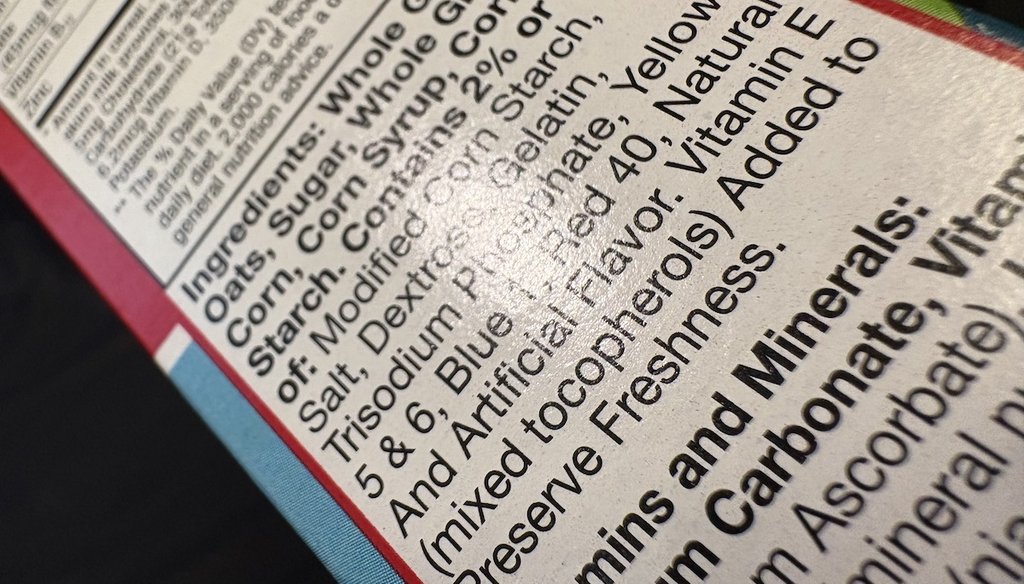
Take trisodium phosphate. Google it, and you’ll get ads for heavy-duty cleaning products used to prep walls before painting. Warning labels say that direct contact with trisodium phosphate powder can be irritating to eyes and skin and even poisonous if exposed in large amounts.
But it is also an ingredient in cereals and many other processed foods including cheeses, soda and baked goods. In small amounts, the U.S. Food and Drug Administration and the European Food Safety Authority say it’s fine in food. It controls pH levels and acts as a leavening agent to make food fluffier.
Initially, I was skeptical, too — could something that works as a heavy-duty cleaner really be OK in food, even in small amounts? But it turns out my mom was right: How much you consume makes a big difference.
“Many food-grade additives share names with industrial products, but concentration makes all the difference,” said Jessica Steier, a public health expert, podcaster and CEO of the science communication organization Unbiased Science. “The food-grade versions are highly purified, used in tiny amounts, and serve specific functions like pH regulation or preservation.”
As I reported on trisodium phosphate and other chemicals used in food, experts consistently said, “the dose makes the poison.” In other words, the toxicity of a substance in large amounts doesn’t necessarily translate to it being dangerous in small amounts.
Here’s another example: sodium bicarbonate. It can be used to clean ovens, unclog drains and extinguish fires. When consumed in large amounts, it can be poisonous.
Sounds like it might be bad to ingest, right? Well, sodium bicarbonate goes by another name: baking soda. Perfectly safe in chocolate chip cookies!
This applies to so many ingredients in our pantries. Table salt, or sodium chloride, is essential for the human body, but too much sodium can lead to health problems like cardiovascular issues and hypertension. Even too much water can be bad for you.
“The same chemical at different concentrations can be either beneficial or harmful (that’s toxicology in a nutshell)” Steier wrote in an email to PolitiFact.
The way you are exposed also makes a difference – something might be safe to put on your skin, but not good to eat. Or, something may be safe to eat, but not safe to inhale. “The route of exposure is very important when considering toxicity,” said Norbert Kaminski, toxicologist and director of the Center for Research on Ingredient Safety at Michigan State University.
But with so many ingredients to parse through, online influencers often point to scary warning labels that apply to chemicals in high doses. And they don’t mention that those warnings don’t apply to the way they usually appear in food: in very small quantities.
A few examples:
-
Calcium disodium ethylene-diaminetetraacetate, or calcium disodium EDTA, is used in food to preserve the flavor, color and texture of foods like canned soda, canned beans and vegetables, dressings and sauces. The U.S. Food and Drug Administration and other global food authorities have deemed it safe for consumption in small amounts. It is also used in cosmetics, cleaning supplies, dental procedures, and to treat heavy metal poisoning. But online, warnings about side effects of medical calcium disodium EDTA, which is administered in higher doses, were used to raise concerns about the use of the additive in fast food sauces.
-
Propylene glycol is an approved food additive in products such as Pop-Tarts, ice cream and cake mix. It is also an ingredient in anti-freeze. But the FDA considers it generally safe to consume in the small quantities in food.
-
Some chemicals used to fluoridate water, like hydrofluorosilicic acid, can be corrosive in their pure form, but when a small amount is added to water at treatment plants, the acid breaks down its different parts and is safe to consume.
The FDA regulates safe levels of food additives. What is considered a “safe level” for a given ingredient is often “several magnitudes lower than what is typically found in animal studies,” to be safe, said Kaminski.
Sometimes online influencers raise concerns about other environmental contaminants that can end up in food, even if they’re not on the ingredients list.
Trace amounts of heavy metals such as arsenic, lead, cadmium and mercury can be detected in some foods — even Girl Scout cookies — because they are in the soil, water or air where foods are grown, raised or processed. This is true for organic food as well.
“Total elimination isn’t possible; these elements are part of the earth’s crust, and attempting zero tolerance could eliminate nutritious foods from our diet without meaningful health benefit,” Steier said. That’s where the FDA’s regulations come in.
So, Thin Mints are safe to eat despite small traces of these metals (but the whole box might give you a tummy ache).
Trace amounts of the herbicide glyphosate can sometimes be detected in food because it is used so widely in agriculture. The Environmental Protection Agency and the FDA monitor these levels and consider small amounts safe to consume.
In many cases, simply running water over fruits and vegetables will help reduce pesticide residues.
So, wash your produce. Eat the things you love as part of a balanced eating plan. And don’t believe every scary ingredient video you see in your social media feed. First ask: How much is there?
